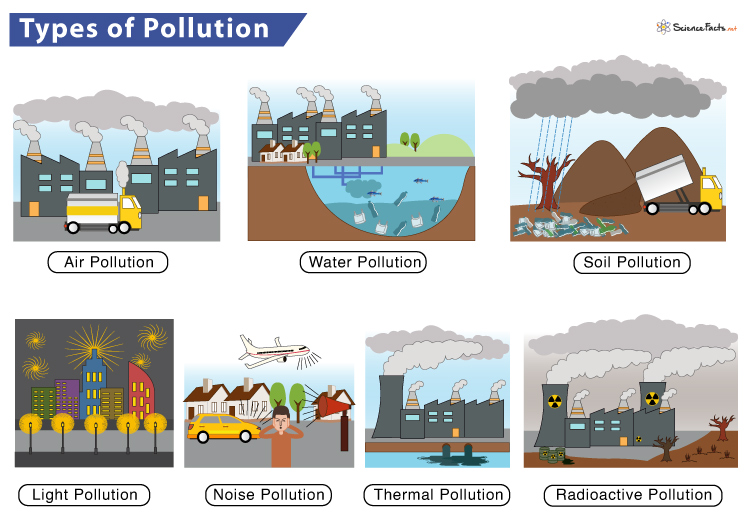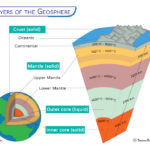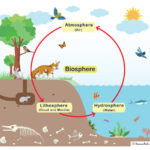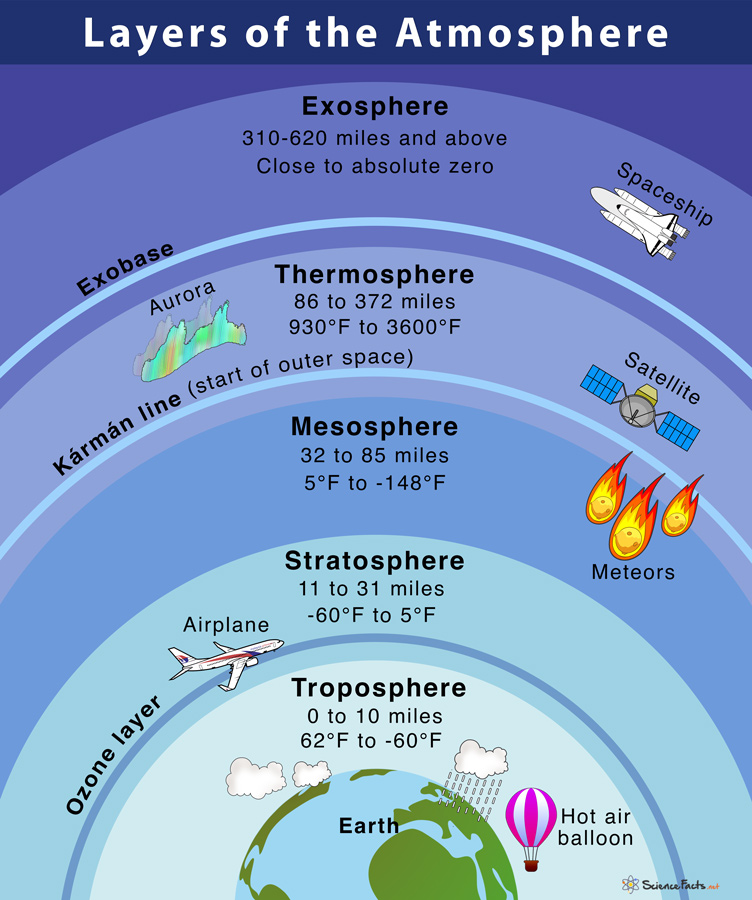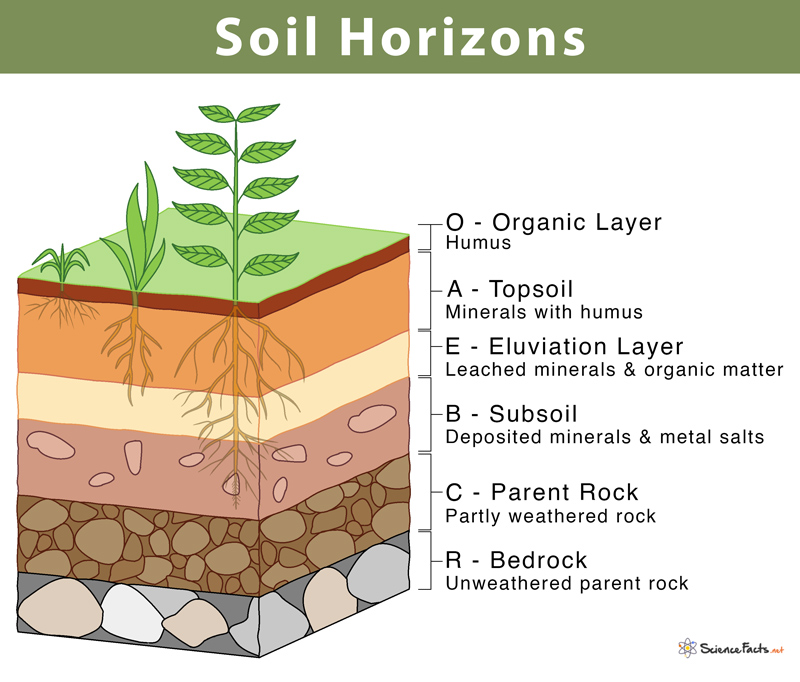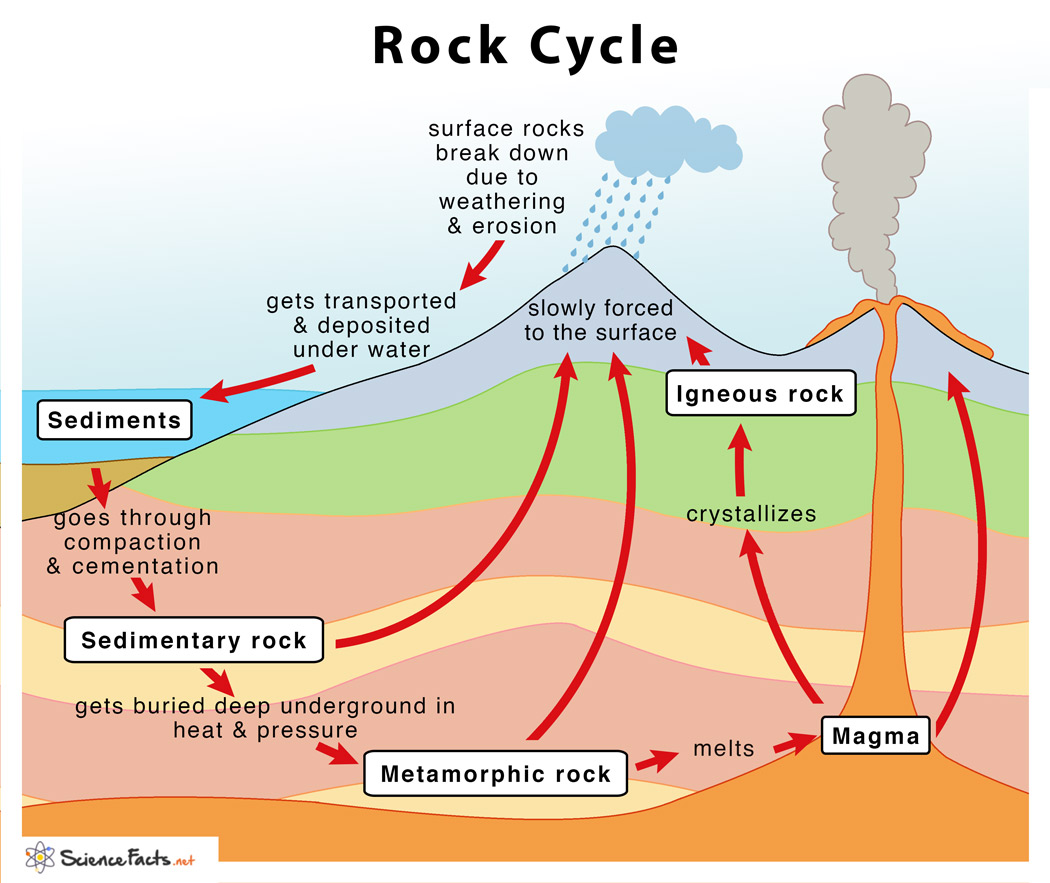Types of Pollution
Pollution is defined as introducing harmful substances (solid, liquid, or gas) or any form of energy (light, heat, sound, or radioactivity) into the environment. The harmful elements that damage air, water, and land quality and cause pollution are called pollutants.
Pollution is primarily human-made, but nature can have an adverse effect also sometimes acts as a source of pollution.
What are the Different Types of Pollution: Causes and Effects
The three major types of environmental pollution are air, water, and soil. Besides these three main types, there are noise, light, thermal, and radioactive pollutions.
1. Air Pollution
The air in our atmosphere has a roughly stable chemical composition consisting of nitrogen, oxygen, argon, carbon dioxide, and trace amounts of other gases. Any change in the air composition due to the addition of unwanted gases such as sulfur dioxide, carbon monoxide, and nitrogen oxides, chemicals, particulate matter, and biological molecules is called air pollution.
Among all other types of pollution, air pollution is found to have the most diverse impact on Earth.
Sources/Causes
Air pollution can happen from both human-made (anthropogenic) and natural sources. Some of the significant sources of air pollution are given below:
- Burning of fossil fuels such as coal, oil, and natural gas
- Exhaust from automobiles and industries
- Indiscriminate cutting of trees (deforestation)
- Wildfires resulting from burning stubble and farm residues
- Release of methane from microbial decay
- Excessive discharge of greenhouse gases like carbon dioxide and nitrous oxide
- Chlorofluorocarbons (CFCs) released from aerosols sprays, refrigerants, and air conditioners
- Release volcanic ash and gases
Effects
- Respiratory disorders in humans such as asthma, lung cancer, chronic bronchitis, and other lung problems
- Formation of smog that reduces visibility
- Formation of acid rain
- Depletion of the ozone layer
- Global warming
- Hazards to wildlife
Prevention
- Planting of trees (afforestation) purifies the air
- Use of renewable energy such as sunlight and wind energy and reducing dependence on nonrenewable sources such as coal, petroleum, and natural gas
- Increasing efficiency in energy usage
- Use of eco-friendly vehicles
- Cleaning of industry emissions before their release into the atmosphere
- Reducing dependence on vehicles
2. Water Pollution
Water pollution occurs when toxic pollutants and particulate matter are introduced into water bodies such as oceans, rivers, lakes, ponds, and aquifers, making them impure and toxic. These contaminants are primarily generated by human activities and sometimes by natural disasters.
Among all other types of pollution, water pollution is found to have the maximum adverse consequences on the ecosystem.
Sources/Causes
- Industrial and domestic sewage discharge
- Oil spills and natural gas leakage into water bodies from underground sites called petroleum seeps
- Social practices such as washing, bathing, and littering in water bodies and religious practices
- Acid rain
- Agricultural runoff containing pesticides, fertilizers, herbicides, slurry, debris, and manures
- Mining and drilling sometimes make underground water contaminated
- Floods and storm carrying dust and debris to the water bodies
Effects
- Algal bloom (eutrophication) caused due to an increase in nutrients of the water bodies
- Reducing dissolved oxygen in the water bodies thus disrupting aquatic life
- Disturbing the pH and salinity of the water bodies leading to loss of aquatic life
- Increasing the risk of water-borne diseases such as hepatitis, cholera, diarrhea, and typhoid in humans
- Increasing the level of toxins and pollutants at each successive level of the food chain (biomagnification)
Prevention
- Proper disposing of domestic, agricultural, and industrial wastes before releasing them into water bodies
- Using sewage treatment methods such as precipitation, ion exchange, reverse osmosis, and coagulation
- Reducing reusing, and recycling of water
- Using plants such as water hyacinth that absorbs heavy metals in areas contaminated with radioactive pollutants
3. Soil Pollution
Sometimes called land pollution, it refers to the degradation of land quality due to unwanted chemicals and other factors in the soil. Such chemicals change the soil’s chemical and biological properties, thus affecting plant growth. Green plants, being the primary producer, absorb those pollutants, which are then passed through the food chain, affecting the whole ecosystem.
Soil pollution can seep into groundwater or run off to the nearest streams and lakes, creating a vicious pollution cycle.
Sources/Causes
- Intensive farming leading to the overuse of agrochemicals such as pesticides, fertilizers, herbicides, slurry, debris, and manures
- Improper disposal of wastes from paper mills, sugar factories, petroleum, and chemical industries
- Dust particles such as silica dust
- Urban wastes consisting of garbage and rubbish materials, dried sludge, and sewage from households and commercial bodies
- Accidental oil spills from oil refineries
- Radioactive pollutants such as radium, thorium, and uranium from power plants
- Acid rain, increasing the acidity of the soil
- Deforestation that increases soil erosion causing low soil fertility
Effects
- Loss of soil fertility making it unfit for agriculture
- Adverse effect on the growth of flora and fauna in the soil
- Groundwater pollution
- Increasing the salinity of the soil, making it unfit for agriculture
- Causing respiratory problems, neuromuscular blockage, and various forms of cancer, especially lung cancer
- Causing nausea, headache, eye irritation, skin rash, and depression
Prevention
- Use of organic matures instead of artificial fertilizers in agriculture
- Planting of trees (Afforestation)
- Treating solid wastes such as garbage, domestic refuse, and industrial materials before dumping them in landfills
- Recovering and recycling of materials such as plastics, cloth, and glass before dumping
4. Other Types of Pollution
1. Light Pollution
Light pollution refers to the excessive amount of light in the night sky. It occurs due to excessive, misdirected, and inefficient lighting systems by humans. It is also called photo pollution that disrupts the ecosystem by reducing the distinction between night and day.
Although light pollution seems to have a lesser impact than any other form, it is expected to have consequences similar to air or water pollution.
Sources/Causes
- Increased energy consumption through over-illumination from artificial light sources such as street lighting, domestic lighting, and garage
- Poor planning by engineers while placing street lights and signage
- Overpopulation increases electricity consumption, which increases glare
- Smog and fog due to air pollution reflect light emitted by cities, making the surrounding look much brighter
Effects
- Produce behavioral changes in animals. Nocturnal animals, who are active at night, venture out during the daytime. In contrast, diurnal animals, which are active during the day, remain active at night
- Affecting migration pattern in seasonal birds
- Difficulty for astronomers to see the stars properly
- Affecting newly hatched turtles that rely on starlight to guide them from the beach to the ocean. They often head in the wrong direction.
- Causing flowering and developmental patterns in plants
- Inducing smog by destroying nitrate radicals, helping in the dispersion of smog, and causing air pollution
- Inducing a delay in melatonin secretion in humans, which delays sleep at night
Prevention
- Reducing the use of decorative lightings that produce more light and consumes more energy
- Use of covered bulbs or light that face downwards
- Switching to an LED light that reduces luminance without compromising visibility
- Proper planning during installation of street lights and signage
- Switching off street lights during daytime
- Using glare-free lighting in the outdoors
- Stopping light-trespass
2. Noise Pollution
It refers to the excessive amount of sound in the surroundings disrupting the natural balance. The acceptable amount of sound is about 60 to 65 decibels, which is the same as our everyday conversation.
Sound levels above 85 decibels are harmful depending on the duration of exposure. Noise above 140 decibels can cause permanent hearing loss. Also, the duration of exposure to the sound is found to have negative health impacts.
Sources/Causes
- Noise from heavy machines in factories, mills, and industries
- Traffic noise from vehicles (trains and buses) and airplanes
- Construction noises from boring and drilling machines
- Noise from firecrackers and loudspeakers in social events
- Household noises from television, mixer grinders, and music systems
Effects
- Loss of hearing and behavioral disorders
- Loss of focus on work leading to low work output
- Stress and Hypertension (high blood pressure)
- Lack of sleep and fatigue
- Difficulty in speech and impairment
- Hearing disorders like tinnitus
- Songbirds, such as robins, fail to communicate and find food
- Disrupting sonar, used by marine animals to communicate and locate food
Prevention
- Honking in public places like hospitals, academic institutions such as schools and colleges should be banned
- Installing adequate soundproof systems in commercial buildings and hospitals
- Afforestation as trees can absorb sound
- Restricting the use of firecrackers during festivities and doing open public rallies
Apart from the types of pollution discussed, there are other forms of pollution called thermal or heat pollution and radioactive pollution.
Thermal pollution is caused due to excessive heat in the environment released from industrial power plants, deforestation, urban sprawl, and air pollution. It increases the Earth’s atmosphere causing drastic climate change and extinction of wildlife. In contrast, radioactive pollution results from accidental leakage from nuclear power plants and improper disposal of nuclear wastes. It can cause massive, long-lasting impacts such as cancer, infertility, blindness, and congenital disabilities.
FAQs
Ans. Air pollution.
Ans. The seven types of pollution are air, water, soil, light, noise, thermal, and radioactive pollution.
Ans. Smog is a type of air pollution. It is a combination of fog and particulate matter that remain suspended in the air.
Ans. Carbon monoxide is a gaseous air pollutant.
Ans. Groundwater pollution can occur due to chemical spills from industries, household runoff during transportation, illegal dumping of wastes, mining operations, and atmospheric depositions.
-
References
Article was last reviewed on Friday, February 17, 2023

